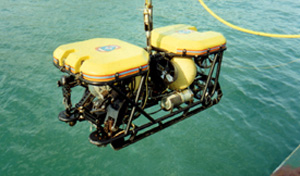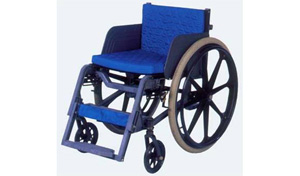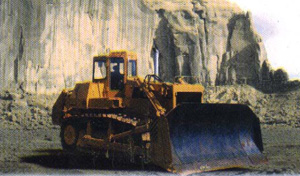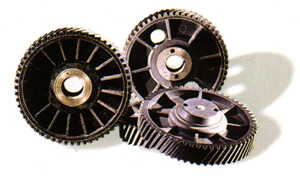|
UVICOM Co Ltd. produces various thermoplastic compositions on a basis carbon fiber reinforcing material. Carbon fibers are characterized by a unique combination is elastic- strength indexes, electro and heat conductivity, biological inertness and low density. Realization of these properties in polymers and the adaptability to manufacture inherent in thermoplast, allow to use these materials instead of nonferrous metals, and in some cases instead of steel designs when especially sharply there is a problem of corrosion firmness. The basic properties Thermoplastic carbon composites (TCC) that found application in various industries resulted in the table - The heterogeneous polymeric system consisting of a thermoplastic matrix (polyolefins, polyamides, polysulphons, etc.), reinforced by a carbon fibre (the maintenance reinforcing material from 5 to 40 % of weights)
- Issued in the form of black granules with a length 3-6 mm and diameter no more than 3 mm.
- Mass fraction of a moisture no more than 0,2 %
- Half-finished product for manufacturing of details of technical appointment by a molding method under pressure, injection molding and tubing.
The material has following indicators of quality (for examples are used carbon polyamide plastics)
Properties thermoplastic carbon fiber-reinforced plastic | Application field TCC | Oil branch | Motor industry | Aircraft | Sea installations | Medicine | The chemical industry | Instrument making | High resistance | + | + | + | + | + | + | + | Chemical firmness | + | + | + | + | + | + | + | Heat conductivity | + | + | + | + | + | + | + | Electric conduction | - | - | - | - | - | + | + | Low constant of friction | + | + | + | + | + | + | - | High durability and non-abrasive quality | + | + | + | + | + | + | - | Shielding of electromagnetic fields | - | - | + | - | - | - | + | Bioinertness | - | - | - | - | + | - | - | Low density | + | + | + | + | + | + | + |
Main efforts of ours engineers and technologists are focused not on creation of a universal material, but on the offer of necessary assortment to the industry. Due to such a concept and taking into account raw polymeric base existing in Russia, compositions on the basis of polyamides and polyolefins have been developed.
PROPERTIES OF CARBON-FILLED PLASTIC ON THE BASIS OF FOSTA NYLON
Properties | CFPA-6/10-1 | CFPA-6/15-1 | CFPA-6/15-2 | CFPA-6/20-1 | CFPA-6/20-2 | CFPA-6/30-1 | CFPA-6/30-2 | Density, g/sm3 | 1,135 | 1,148 | 1,180 | 1,160 | 1,20 | 1,190 | 1,250 | Breaking point at a bend, MPa, not less
| 90 | 110 | 140 | 120 | 180 | 140 | 220 | Modulus of elasticity, GPa, not less | 4,45 | 6,33 | 7,5 | 7,02 | 9,5 | 8,67 | 12,0 | Breaking point at a stretching, MPa, not less
| 61 | 72 | 100 | 83 | 120 | 100 | 160 | Specific impact strength on Sharpi, kJ/m2, not less | 12,5 | 9,5 | 14 | 8,5 | 12 | 8,4 | 18 | Vicat heat stability, °С | 195 | 205 | 205 | 210 | 210 | 215 | 215 |
Delivery UPA-6/35 and UPA -6/40 on request of the customer is possible
THE COMPARATIVE TABLE OF PROPERTIES BASE AND HYBRID CARBON FIBER-REINFORCED PLASTIC ON THE BASIS OF PA -6
The name of indicators | CFPA-6/30 | CFPA-6/15 | | СВ | СШ | The content of glass-filler, % | 0 | 0 | 10 | 15 | 20 | 30 | 10 | 15 | 20 | Bending strength, MPa | 264 | 174 | 199 | 210 | 220 | 242 | 191 | 195 | 198 | The elasticity module at a bend, Gpa | 17,5 | 6,9 | 8,4 | 9,2 | 9,9 | 11,4 | 7,3 | 7,9 | 8,5 | Tensile strength at break, MPa | 174 | 119 | 160 | 165 | 170 | 181 | 126 | 127 | 127 | | Relative elongation, % | 2,3 | 4,3 | 3,9 | 3,8 | 3,7 | 3,6 | 4,1 | 4,0 | 3,9 | | Sharpy impact value, kJ/m2 | 21,5 | 33 | 45 | 47 | 49 | 54 | 49 | 44 | 40 | Specific superficial resistance, Ohm | 104 | 107 | 108 | 108 | 108 | 108 | - | - | - | Linear shrinkage
effect at moulding, %
Lengthways
across | 0,23
0,35 | 0,45
0,57 | - | - | - | - | 0,43
0,43 | 0,47
0,47 | 0,50
0,50 |
SOME PROPERTIES OF CARBONATED POLYPROPYLENE
The name | Mark of carbonated polypropylene | CFPP-15 | CFPP-30 | CFPP-30-М | Density, g/sm3 | 0,98 | 1,06 | 1,06 | Fusion temperature, °С | 164 | 166 | 166 | Tensile strength, MPa | 85 | 97 | 105 | | The elasticity module at a bend, gPa | 6,5 | 10,5 | 10,0 | Linear shrinkage effect at moulding, % | 1,0 | 0,4 | 0,5 | Specific superficial electric resistance. Оhm | 1014 | 105 | 105 | | Specific volume electric resistance, Ohm cm | 1012 | 103 | 103 | coefficient of friction | - | 0,22 | - |
ANTIFRICTIONAL MATERIALS
Patent № 2237690 from October, 10th 2004 (the Polymeric composition for an antifriction material; a priority from 23.01.2003)
At high loadings and small backlashes; - In the presence of a dirt;
- In absence of greasing;
- In damp corrosive environments and under water:
- For maintenance of long term of operation of the loose leaf and a metal finger;
- At operation of knot of a friction in the liquid environment;
- In chemically-excited environments
COMPARATIVE TABLE OF PROPERTIES OF ANTIFRICTIONAL MATERIALS
Material | P•V,MPa*m/sec | Tf, °C | I, g•104/h | Ктр | σ, MPa | E, GPa | TVicat, °C | comments | PA-6 | 0,05-0,6 | - | 4.6 | 0,32 | 65 | 1,45 | 190 | - | CFPA-6/15-2 | 0,3-0,3 0,1•1 0,5-0,003 | -
100 20 | -
10
+2 | 0,19
0,7
0,17 | 180 | 8,0 | 205 | dry friction | CFPA-6/15-2-AF | 0,1•1 0,5-0,003 | 45
20 | 3,4
0 | 0,27
0,19 | 140 | 7,0 | 200 | FLTE=1,2*10-50K
dry friction | CFPP-30-2 | 0,3•0,3 0,1•1 0,1•1 | -
60
20 | -
9
3 | 0,22
0,35
0,05 | 44 | 9 | 170 | FLTE=2*10-50K
sea water friction | CFPP-30-M | 0,1•1 | 35
20 | 12
+7 | 0,25
0,04 | 122 | 9,2 | 174 | dry friction
sea water friction |
P•V - Loading х speed,
Тк - temperature in a friction zone,
I - deterioration,
Ктр - factor of a friction,
σ - durability at a bend,
Е - the elasticity module at a bend,
ТVick - temperature constancy on Vick,
КЛТР - factor of linear thermal expansion
Recommended operation temperatures:
For UPA-6/15-AF – 50 – 150°C,
For UPP-30М – 50 – 130°C.
INFORMATION ABOUT THE FIRMNESS OF MATERIALS TO VARIOUS ENVIRONMENTS
Medium | Concentration | CFPA-6 | CFPP | | Sulfuric acid | 3%
30%
концентр. | 1
1
1 | 3
3
3 | Nitric acid | 10%
40%
концентр. | 1
1
1 | 3
3
2 | Hydrochloric acid | 10%
концентр. | 1
1 | 3
3 | Sodium hydroxide | 10%
60% | 1
3 | 3
3 | Kerosene | - | 2 | 2 | Gasoline | - | 2 | 2 | Acetone | - | 2;3 | 3 | Ethanol | - | 3 | 3 | Dichloroethane | - | 1 | 1 | Benzene | - | 3 | 2 | Phenol | - | 1 | 3 |
1 unsatisfactory firmness;
2 satisfactory firmness;
3 good firmness.
Offered materials used in production of spherical support of a suspension bracket of cars, various bushings, sealing and regulating rings, cogwheels etc. Replacement of nonferrous metals in friction knots leads to decrease in expenditures for machining operation and product weight and also leads to service life increase. Materials are produced in the form of granules which are easily processed by methods of injection molding and pressure casting, as usual thermoplastic materials. Materials delivered in bags on 25 or 20 kg.
PROPERTIES OF ANTISTATIC NOT EASILY COMBUSTIBLE COMPOSITIONS ON THE BASIS OF FOSTA NYLON
Properties | Norm for mark | CFPA-6/15AP | CFPA-6/20AP | CFPA-6/30AP | external view | Granules of colour asphalt | grain composition | Length of granules of 2-6 mm | Density, g/sm3 | 1,35 | 1,42 | 1,48 | Bending pressure at the maximum loading, MPa, not less | 150 | 165 | 190 | The elasticity module at a bend, gPa, not less | 6,5 | 8,0 | 12 | Breaking stress at a stretching, MPa, not less | 100 | 120 | 130 | | Sharpy impact value, kJ/m2 | 25 | 20 | 18 | Firmness to ignition at influence of the heated wire, heeated to 960°С. | Не воспламеняется | Firmness to the flame not more, sec | 15 | 15 | 15 | Specific superficial resistance. Оhm | 106 | 105 | 104 | Vicat heat stability, °С | 190 | 195 | 200 | Molding shrinkage loss | 0,4 ÷ 0,5 | 0,35-0,45 | 0,25-0,4 |
MEDICAL PURPOSED CARBON FIBER-REINFORCED PLASTIC
Properties | CFPA-12/10-A | CFPA-12/15-A | CFPA-12/20-A | CFPA-12/30-A | CFPA-12/40-A | Density, g/sm3 | 1,060 | 1,095 | 1,120 | 1,160 | 1,205 | | Breaking stress at a bend, MPa, not less | 100 | 130 | 150 | 170 | 180 | | The elasticity module at a bend, gPa, not less | 4,0 | 7,0 | 9,0 | 11,5 | 14,0 | Breaking stress at a stretching, MPa, not less | 85 | 110 | 120 | 130 | 135 | Specific impact strength on Sharpi, kJ/m2, not less | 45 | 40 | 35 | 28 | 25 | Vicat heat stability, °С | 165 | 170 | 175 | 1180 | 180 |
COMPOSITE MATERIALS OF BIOMEDICAL APPOINTMENT WITH CARBON FIBER FILLING MATERIAL
(The patent of the Russian Federation № 2197509)
UVICOM Ltd. together with A. N. Nesmeyanov Institute of Organoelement Compounds the Russian Academy of Sciences with the assistance of scientific staff (The responsible developer from UVICOM Ltd.: Rashkovan I.A. Candidate of Science (Engineering), the responsible developer from A. N. Nesmeyanov Institute of Organoelement Compounds the Russian Academy of Sciences: Krasnov A.P. Doctor of Chemistry) develops composite polymeric materials of biomedical appointment with carbon filling materials. The basic components of offered materials along with plastic binder are biocompatible filling materials: hydroxyapatite, carbon fibers, etc.
The developed materials combine the high physical and mechanical indicators necessary for operation of constructional materials, such as durability at a bend, hardness, firmness, impact strength, with low value of a contact angle that provides good biocompatibility of a material with living tissues. The structure of materials redounds to formation of precursor cells from marrowy isolate.
As a result of tests it has been shown that the most successful is use of these materials as implant-prosthetic device for endoprosthesis replacement in surgery (the certificate of tests of a material on osteointegration and biocompatibility № 11 from …. Moscow State University of Medicine and Dentistry). Also their application effective in the form of products of a complex configuration in the bone plastic arts and maxillofacial surgery (the certificate of tests of products on osseointegration and biocompatibility № 15 from … Moscow State University of Medicine and Dentistry).
Availability of initial components, adaptability to manufacture of processing by a moulding method under pressure promotes successful use of these materials in craniofacial surgery, at prosthetics of various skeletal parts, and also for use in fixing radiotransparent and the biocompatible details used in the operational techniques. Of materials of this type using modern methods of processing make biocompatible half-finished plates of a various thickness and products of a complex configuration for replacement of defects of a bony tissue.
UVICOM Ltd. has prepared the necessary technical specification coordinated with A. N. Nesmeyanov Institute of Organoelement Compounds the Russian Academy of Sciences, for manufacturing of biocompatible carbon materials.
MAIN ADVANTAGES COMPARING WITH METALS - 5 times lower energy costs at production
- 4 times lighter than the metal parts
- increased corrosion resistance
- part dimension stability at thermal variations
- high strength parameters
- friction coefficient 1,5-2 times lower
- high wear resistance and resistance to the actions of aggressive media
- good heat and electric conductive
- antistatic properties
- minimal rate of waste products
- environmental friendly
APPLICATION Chemical, oil-extracting and processing the industries: - rotor pump fins and turbine wheel fins
- Sliding bearings: locating and sealing rings
- Pumps for deep drilling of oil wells
- Capacities for storage of aggressive environments
- Capacities for storage of compressed liquid: details of chemically proof pumps
- Details of transport conveyors; electrofilters in sulfuric manufacture, section isolation valves for oil pipelines; and gas pipelines
Motor industry: - Petrol tanks
- Pads of trunnion balls
- Bushings of an axis of a pendulum of steering draught
- Bearings and other details of friction knots working in conditions with limited greasing or without greasing
- Pumps
- Bumpers
- Sealing and compression ring etc.
The textile industry: - Shuttles of weaving looms, shaft and pulleys
- Power frames, lattices
- Spindles, ring travelers (thread guide) etc.
Medical equipment and medicine: - Osteosynthesis fixators at orthopedic operations
- Cardiograph sensing devices
- Bearings for drills and other details of the medical equipment
Electronic engineering industry: - TV, radio and video equipments cases and the cases of devices providing protection against electromagnetic interference
- Cases of video-and audiocassettes cartridges;
The food processing industry.
|








